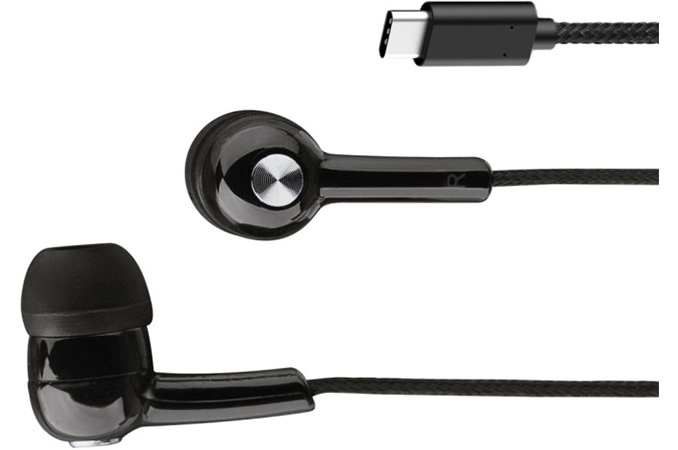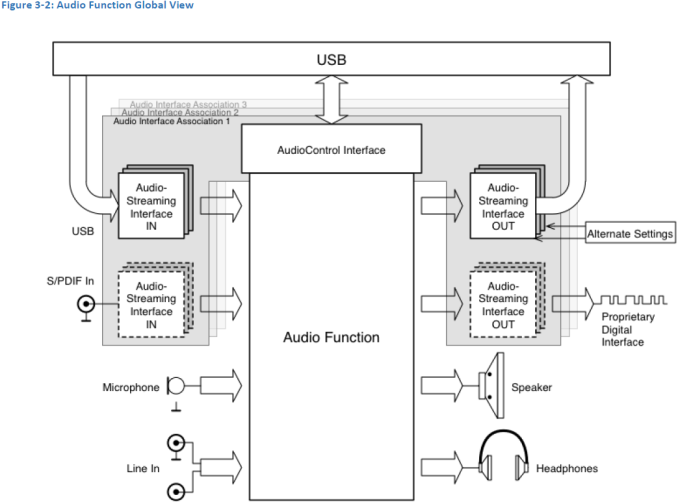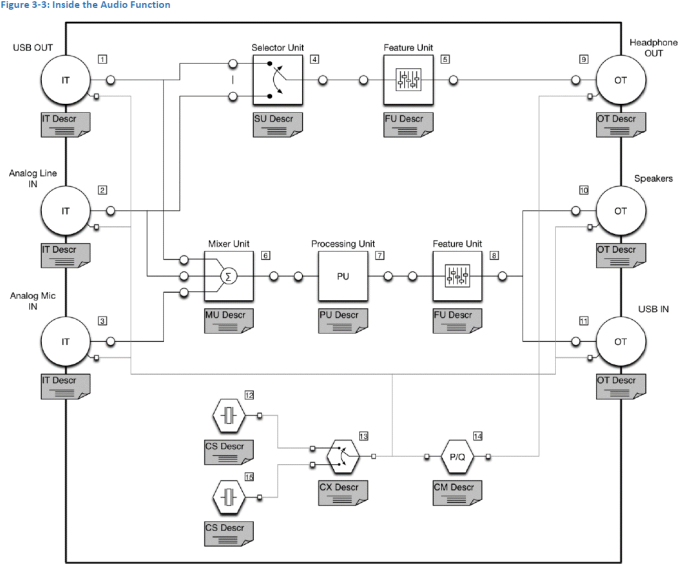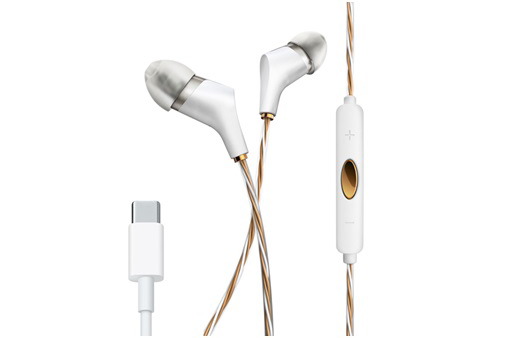USB-IF Publishes Audio over USB Type-C Specifications
by Anton Shilov on September 30, 2016 12:00 PM EST- Posted in
- Mobile
- USB-C
- USB-C Digital Audio

The USB Implementers Forum this week published the USB Audio Device Class 3.0 specification, which standardizes audio over USB Type-C interface. The new spec enables hardware makers to eliminate traditional 3.5mm mini-jacks from their devices and use USB-C ports to connect headsets and other audio equipment. Makers of peripherals can also build their audio solutions, which use USB-C instead of traditional analog connectors. Developers of the standard hope that elimination of mini-jacks will help to make devices slimmer, smarter and less power hungry.
The industry, led by Intel and some other companies, has been mulling about replacing the traditional 3.5mm mini-jack connector for some time now. The main motives for replacement were necessity to simplify internal architecture of devices by removing analog and some audio processing components from the inside (which leads to further miniaturization), minimize the number of external connectors, improve power management as well as to add smart features to headsets and other audio equipment. We discussed USB Type-C Audio Technology briefly earlier this year and mentioned that this is not the first time that the industry has tried to use USB instead of the good-old mini-jack. The important difference between contemporary initiative and attempts in the past is the fact that today the primary goal is to replace the 3.5mm jack in portable devices.
As reported, the USB Audio Device Class 3.0 specification supports both analog and digital audio. Analog audio is easy to implement and it does not impact data transfers and other functionality of USB-C cables since it uses the two secondary bus (SBU) pins. Some device makers may find the analog audio feature of the standard to be a relatively simple way to add certain smart capabilities to their headsets without major redesign of hosts. While analog USB-C audio will not help to shrink dimensions of portables, it could be particularly useful for non-mobile devices, where miniaturization is not crucial, but where port space is at a premium or where additional features either make sense (infotainment, sport equipment, etc.) or are fundamental (VR HMDs).
The USB ADC 3.0 defines minimum interoperability across analog and digital devices in order to avoid confusion of end-users because of incompatibility. In fact, all ADC 3.0-compliant hosts should support the so-called headset adapter devices, which allow to connect analog headsets to USB-C. However, digital audio is one of the primary reasons why companies like Intel wanted to develop the USB-C audio tech in the first place, hence, expect them to promote it.
According to the USB ADC 3.0 standard, digital USB-C headphones will feature special multi-function processing units (MPUs), which will, to a large degree, define the feature set and quality of headsets. The MPUs will handle host and sink synchronization (this is a key challenge for digital USB audio), digital-to-analog conversion, low-latency active noise cancellation, acoustic echo canceling, equalization, microphone automatic gain control, volume control and others. Such chips will also contain programmable amplifiers and pre-amplifiers, which are currently located inside devices. Besides, USB ADC 3.0-compatible MPUs will also support USB Audio Type-III and Type-IV formats (the latest compressed formats), but will retain compatibility with formats supported by ADC 1.0 and 2.0. Finally, among the mandated things set to be supported by USB-C Audio devices are new Power Domains (allows devices to put certain domains in sleep mode when not in use) as well as BADD (basic audio device definition) 3.0 features for saving power and simplified discovery and management of various audio equipment (each type of devices has its own BADD profile).
Over the past few months, Conexant has introduced three USB-C Audio MPUs (1, 2) for headsets, docking stations and other equipment. Assuming that these chips are compliant with the USB ADC 3.0 specs from a hardware standpoint, and the software is ready, actual devices featuring USB-C Audio could arrive in the coming months. Pricing of the first USB ADC 3.0-compliant MPUs is unknown, but in general MPU ICs do not cost too much. Moreover, as developers adopt smaller process technologies and a larger number of such chips hit the market, their prices are going to decline. In the end, it will be interesting to see where digital headphone prices end up. The MPUs will definitely add to the total bill of materials for a set of headphones, but at the same time they add new functionality as well, so the big question is how manufacturers then factor all of that into device pricing.
A number of companies, including Apple and LeEco, have already introduced smartphones that do not use traditional mini-jacks, and Google added support for USB DAC devices to Android over a year ago. The finalization of the USB ADC 3.0 spec, introduction of USB-C audio ICs, as well as design decisions of smartphone makers demonstrate that the industry is trying to eliminate 3.5mm jacks from mobile devices. The big question is whether the rest of the industry plans to do the same. It is true that portables are primary devices for music listening for many people. However, there are tens of applications which still rely on analog connectors, and hundreds of millions of people who use them either to consume or create content. To eradicate 3.5mm jacks completely, USB-C Audio promoters will have to work with thousands of vendors and this takes time. Consequently, it is too early to say that this is the end for the good-old mini-jack.
Images by Conexant, USB IF.
Source: USB IF













93 Comments
View All Comments
OnKillingTree - Tuesday, October 4, 2016 - link
It's like saying that person who came from 1 USB port computer to 2 UBS ports computer, doesn't know where to plug his mouse. You just connect to either of them and it works!melgross - Saturday, October 1, 2016 - link
Well then, in three of four years you won't be buying anything new. Too bad for you.StrangerGuy - Friday, September 30, 2016 - link
I find it doubly ironic about this forced obsolescence nonsense when said industry that promotes it can't even cheap and reliable USB-Type C cables to save their lives.MobiusStrip - Saturday, October 1, 2016 - link
Have you tried to find a USB 3 hub that's worth a rat's ass? They don't exist. They are all defective garbage. Read the negative reviews on any of them, and you'll find that they all die in a matter of weeks or months. I've experienced this at least three times. Now I simply have an extension cable on my desk, and I have to unplug and re-plug any USB device I need to use.Which is another reason that USB is NOT a substitute for Thunderbolt; Thunderbolt (in addition to being far superior for video and high-speed data I/O) can be daisy-chained.
BedfordTim - Saturday, October 1, 2016 - link
My Anker 8 port USB3 hub has been working for years but you are right in that there is a lot of stuff that doesn't work even from big names.MattMe - Monday, October 3, 2016 - link
I second Anker USB3 hubs being of good waulity. I use mine for music production purposes where the difference between shoddy and good is instantly noticeable with multiple devices connected to one PC port.Anker is the only one I've had so far that has worked as I'd expect any hub to work. Expensive, for sure, but worth it.
Mythbinder - Saturday, October 1, 2016 - link
USB has always had the ability to be daisy chained, 1 USB port can support upto 7 chained devices. its in the spec, but no one ever used it so devices and cables are not built to do it.Wardrop - Saturday, October 1, 2016 - link
Yeah that's because daily chaining sucks. Always has, always will. Thing wiring. Star configuration always trumps ring configuration.BiggerInside - Friday, September 30, 2016 - link
This is smoke and mirrors. If there's a speaker on the device, you've already got DAC going on. If you're supporting analog audio over the usb type-c connector, youǘe already got all the DAC in place that you'd need to connect an analog headphone jack. cf: iPhone 7, with the same three audio chips that the iphone 6 had.
This is, obviously, the only one of these features that actually requires the change, and probably the one we want the least (I need to charge and use headphones at the same time, which requires either two ports or a hub. Iĺl take two ports. If the alternative was dual USB ports... maaaaybe...)
I haven seen any demonstration of parasitic drain from the headphone jack. Detecting whether headphones are plugged in is trivial--and I sincerely doubt the analog-headphone-detection algorithm works any differently in the USB world than it has with the old port.
Here's the one point that actually aims at providing anything substantive, and it sounds like a compelling argument. If you actually think about whatś being said, though, it falls apart.
"we want to remove the headphone jack so our headphones can connect over USB and have new digital features!"
LOL.
Nothing about the headphone jack prevents anyone from making a USB headset.
The only thing this move does is force people to buy adapters for existing headphones, and pushes new headphones to use DAC chips they didn't need. Seriously. These chips are 100% redundant for headphone audio.
Laughing all the way to the bank.
sanf780 - Friday, September 30, 2016 - link
The thing is the number of DACs and the quality of those. There are tricks you can use on the DACs for the phone speakers because the speakers are of a known tight specification, that is generally poor (it is hard to make small nice sounding loudspeakers). It is an engineer's work to not overdo things, to match a so and so loudspeaker with a so and so DAC.Headphone amps are not trivial to design - I know, I have been there. The headphones have very different characteristics, with impedances as low as a few ohms up to hundreds of them. THD becomes important as there is a chance of need to deliver audio to a great sounding headphone (you know, the ones that pinpoint how harsh MP3 sound). I probably can go on and on. *sigh* It is so much easier to get something done in the digital domain these days. And lower power to boot.
The big problem I see with the removal of the jack is the incovenience. We are used to have passive headphones and do not care about the DACs. After all, DACs tend to be expensive if they are not built into an appliance.